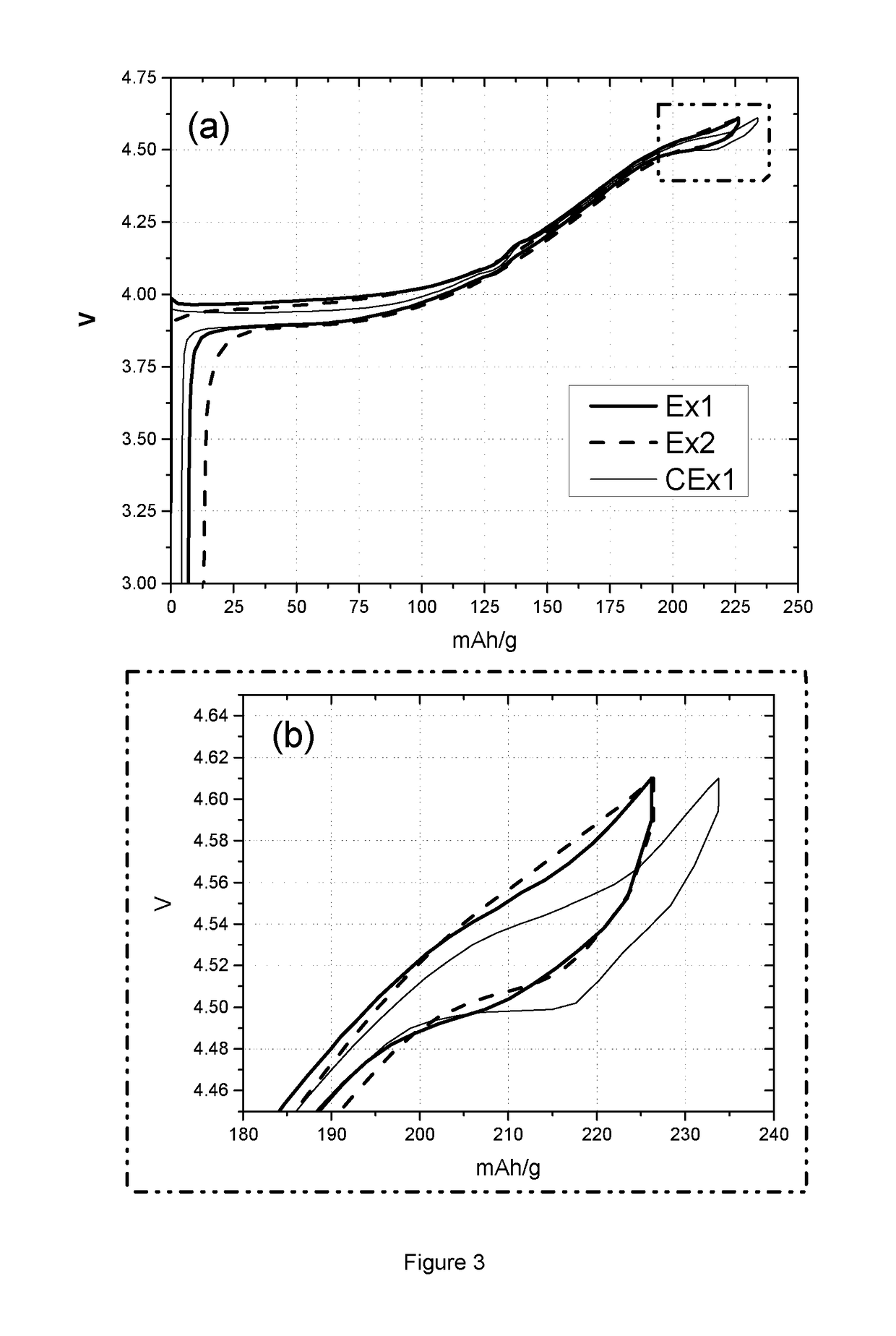Lithium Battery Containing Cathode Material and Electrolyte Additives for High Voltage Application
a lithium ion battery and additive technology, applied in batteries, cell components, electrochemical generators, etc., can solve the problems of inability to cycle in a stable manner at high voltage, limited cathode system, and fast capacity fading
- Summary
- Abstract
- Description
- Claims
- Application Information
AI Technical Summary
Benefits of technology
Problems solved by technology
Method used
Image
Examples
example 1
Counter Example 1
[0087]This example presents Al-, Ti- and Mg-doped LiCoO2-based powder. This material is manufactured following the same steps as the preparation of Ex1 except that in the second step the molar content of MgO, Al2O3 and TiO2 powders vs. total Co is changed to 0.18% / 0.348% / 0.283% (Mg / Al / Ti). The prepared powder is named CEx1. It is applied as cathode material and tested following the description of “Coin cell test” and “Floating test”.
Discussion of Example 1, Example 2 and Counter Example 1
[0088]Table 3 lists the coin cell and floating test results of sample Ex1, Ex2 and CEx1. Coin cell tests provide charge and discharge capacity (CQ1 and DQ1) in the first cycle, and capacity lost after 98 times of cycling at 0.2C in the voltage range of 4.4 to 4.61V. The charge capacities of sample Ex1 and Ex2 are smaller than the value of sample CEx1, as is the case also for discharge capacity. This phenomenon can also be observed from FIG. 3, where graph (a) shows the 1st cycle vol...
example 2
Counter Electrolyte with Additives of SN
[0096]This example presents a rechargeable lithium ion battery prepared through the same procedure as Cell 1, except that the electrolyte additives (c) only comprise 2 wt % of succinonitrile (SN). The prepared 650 mAh pouch-type battery is named Cell 2.
Counter Example 3: Electrolyte with Additives of SN and LiBF4
[0097]This example presents a rechargeable lithium ion battery prepared through the same procedure as Cell 1, except that the electrolyte additives (c) only comprise 2 wt % of succinonitrile (SN) and 0.2 wt % of lithium tetrafluoroborate (LiBF4). The prepared 650 mAh pouch-type battery is named Cell 3.
example 4
Counter Electrolyte with Additives of SN and PRS
[0098]This example presents a rechargeable lithium ion battery prepared through the same procedure as Cell 1, except that the electrolyte additives (c) only comprise 2 wt % of succinonitrile (SN) and 0.5 wt % of propene sultone (PRS). The prepared 650 mAh pouch-type battery is named Cell 4.
Counter Example 5: Electrolyte with Additives of SN and VC
[0099]This example presents a rechargeable lithium ion battery prepared through the same procedure as Cell 1, except that the electrolyte additives (c) only comprise 2 wt % of succinonitrile (SN) and the solvent has been modified by adding 1 wt % of vinylene carbonate (VC). The prepared 650 mAh pouch-type battery is named Cell 5.
PUM
 Login to View More
Login to View More Abstract
Description
Claims
Application Information
 Login to View More
Login to View More - R&D
- Intellectual Property
- Life Sciences
- Materials
- Tech Scout
- Unparalleled Data Quality
- Higher Quality Content
- 60% Fewer Hallucinations
Browse by: Latest US Patents, China's latest patents, Technical Efficacy Thesaurus, Application Domain, Technology Topic, Popular Technical Reports.
© 2025 PatSnap. All rights reserved.Legal|Privacy policy|Modern Slavery Act Transparency Statement|Sitemap|About US| Contact US: help@patsnap.com



